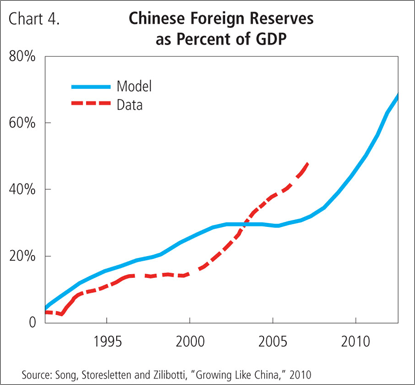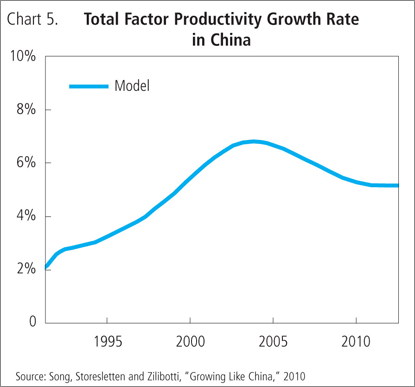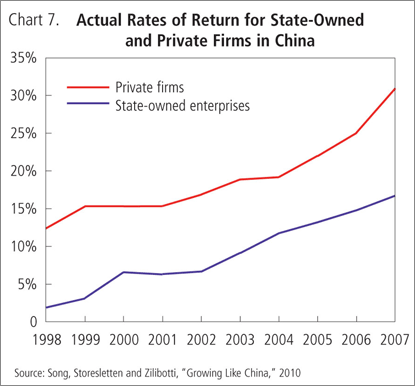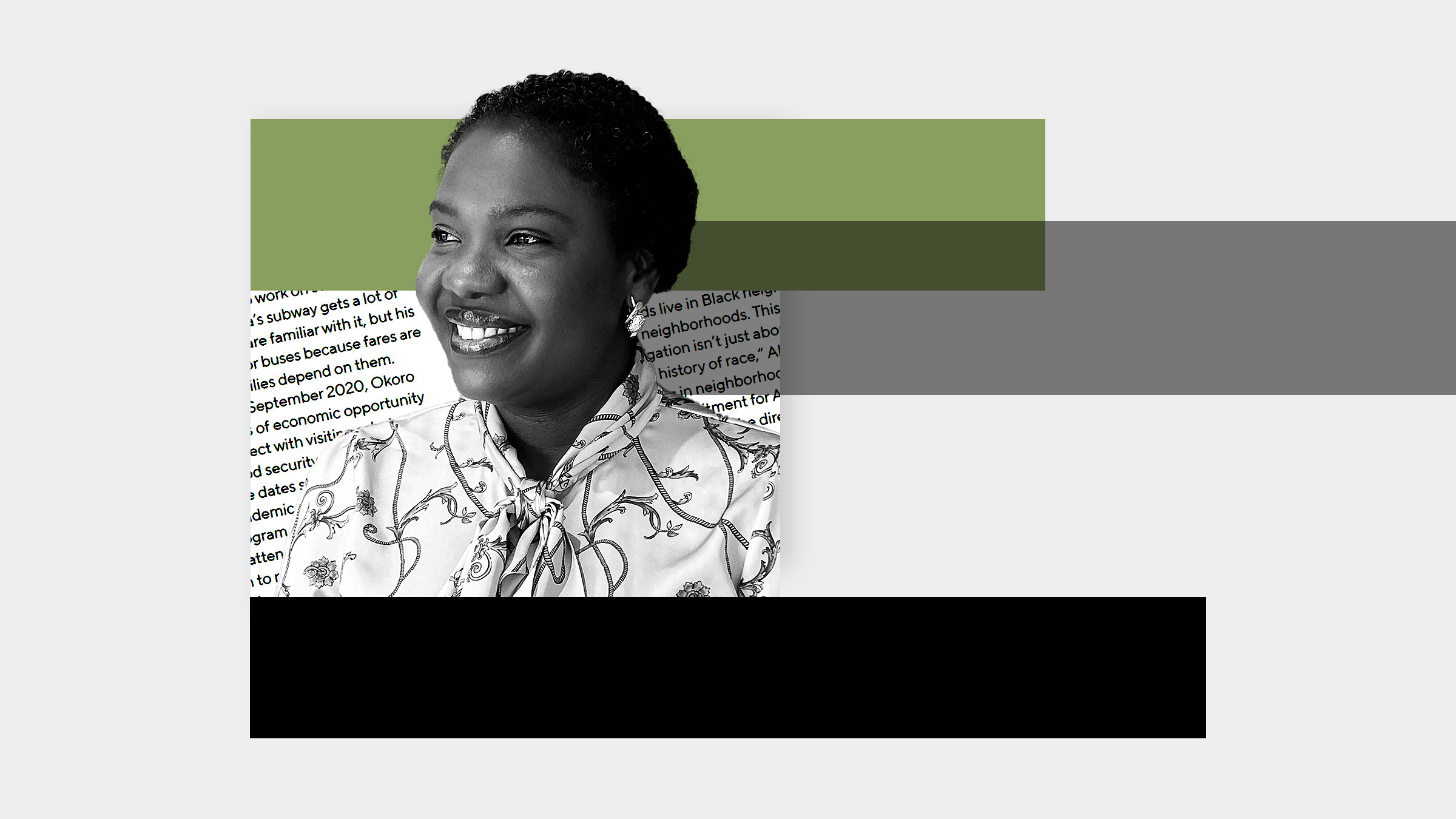 In recent decades, few phenomena have been as globally significant as China’s astonishing economic transformation. Over a matter of years, it has transitioned from a poor nation dominated by small farmers and enormous, plodding state-owned enterprises into a dynamic economy where private companies shape international markets and annual GDP growth surges past expectations. As this is written, economists predict that China will soon eclipse Japan as the world’s second-largest economy, and it is arguably only a matter of time before the United States, too, places second.
In recent decades, few phenomena have been as globally significant as China’s astonishing economic transformation. Over a matter of years, it has transitioned from a poor nation dominated by small farmers and enormous, plodding state-owned enterprises into a dynamic economy where private companies shape international markets and annual GDP growth surges past expectations. As this is written, economists predict that China will soon eclipse Japan as the world’s second-largest economy, and it is arguably only a matter of time before the United States, too, places second.
Also remarkable is how China’s growth patterns have usurped several core predictions of conventional economic theory. Standard models suggest that capital will flow to where it can be used most profitably; if rates of return are higher in productive country A than in low-productivity country B, capital will flow to A. The same thought applies to companies: Lenders will invest in productive firms that promise higher returns.
But in reality, fast-growing, highly productive China sends an enormous amount of resources to other countries—most notably by buying U.S. Treasury bills, though they pay very little interest—when companies within China could put those resources to use by investing in profitable domestic firms with far higher rates of return. Surprisingly, within the nation, bank loans tend to flow to firms that are relatively unproductive—an inefficiency that is one of the few apparent brakes on China’s otherwise unrelenting economic expansion.
What explains these anomalies? Political commentators often argue that the foreign surplus occurs because China manipulates exchange rates, holding the yuan at an artificially low level to the dollar so as to curb spending on imports while flooding foreign markets with underpriced Chinese exports. But recent research by Minneapolis Fed senior economist Kjetil Storesletten and his colleagues provides a simpler explanation, one that relies on disparities among China’s firms in their relative productivity and access to credit. Their story, fashioned into a mathematical model, provides a close match to the data patterns seen in China’s economy over the past 20 years and suggests that China’s growth experience and growing surplus must be understood in light of the structural change the country is going through.
A theory of structural change
In “Growing Like China,” forthcoming in the American Economic Review, with coauthors Zheng Song of Fudan University and Fabrizio Zilibotti of the University of Zurich, Storesletten proposes a “theory of economic transition” that accounts for both the growing foreign surplus and the high growth/high return to capital that China has experienced in recent decades.
“What motivated this work,” said Storesletten in a recent interview, “was that we were totally puzzled by two observations. Number one: The rate of return from capital in China is very, very high. That has been shown to hold true if you look at aggregate data or micro data. And number two: At the same time, China is building up a huge surplus [of savings]. So why on earth would a country buy low-paying T-bills instead of exploiting the high rate of return on capital?”
According to neoclassical theory, a country with a high domestic return to capital should attract large capital inflow from investors in other nations. But China has manifested the opposite. Indeed, foreign reserves soared from $21 billion in 1992 to $2,130 billion in 2009.
Of course, China’s economy grew at a blistering pace during those years; perhaps the rapid growth in foreign reserves simply represents a constant share of growing economic output. No, the surplus grew faster than the economy itself; in 1992 the surplus/GDP ratio was 5 percent, but by 2009 it was 46 percent (see Chart 1).
“That puzzled us,” said Storesletten, “and motivated us to write down a model that asked, ‘What if China’s savers just cannot get the good investments?’ That idea pushed us in a certain direction, and along the way we discovered a bunch of other very interesting facts.”
Very interesting facts
The economists document a number of intriguing empirical realities about China, trends that contrast strongly with economic growth in most other nations. For example, in the United States and Europe, wages have tended to grow at about the same rate as output per worker, Storesletten observes, but in China, the wage rate has increased far less than the value added by workers. So “it is very clear that the pattern of growth is very different from anything that we’ve seen.”
Of course, this pattern grows out of another set of very special circumstances. Until the early 1990s, virtually all industry and all economic activity in cities were state owned. Private industry was essentially absent. But in the aftermath of the Tiananmen Square uprising in 1989 and following Deng Xiaoping’s Southern Tour in 1992, the Chinese government began to let private enterprise emerge in every aspect of the economy other than the financial sector. (See the Focus on China articles in the December 2003 Region.)
As a result, investment rates have been exceptionally high, nearly 40 percent. One would expect that over time rates of return on that investment would begin to fall as the most profitable opportunities become saturated. Yet in China, “the rate of return to capital in manufacturing has been increasing since the early 1990s,” write the economists, citing an estimate close to 35 percent in 2003.
Ironically, while corporate rates of return are very high, bank savings accounts have yielded little for individuals, just above 0 percent interest. Nonetheless, the Chinese save at incredibly high rates; some estimates put the figure as high as 40 percent of disposable income. Storesletten suggests that the reasons lie in China’s huge structural transition that removed the social safety net on which many had relied.
“People are saving like crazy in China. An important reason is that the environment is much riskier than in the 1980s.” Why riskier? Because state-owned firms began to shed workers, and private companies who hired them provided fewer benefits and less job security.
“When you look at these numbers, it’s just stunning,” said Storesletten. “In manufacturing, for example, the share of the labor force employed by private employers was less than 10 percent as late as 1994, and it’s above 60 percent now. For the urban sector as a whole, the growth is even larger. So we’re really seeing a very rapid change from state-owned firms toward private firms.” In less than 15 years, firms change ownership, companies close down and more are created. “Workers find themselves shifted from safe jobs in state-owned firms to a highly uncertain environment with private employers.”
And while workers’ wages grew during this time span, they didn’t increase at the same pace as labor productivity or per capita GDP (for low- to medium-skilled workers, real wages grew about 6 percent annually from 1992 to 2004 compared with 9 percent real GDP per capita growth. Moreover, entrepreneurial earnings grew far faster than wages did, resulting in growing inequality—another salient feature of China’s economy.) “Suddenly, people have very risky wages; pensions become highly uncertain. People needed to save a lot more. You would see increased savings rates, not only for the young, but also for the old.”
As a result, banks began to accumulate more and more savings deposits, while their primary borrowers, state-owned firms, were taking out fewer loans as their share of production rapidly declined. “So the banks then become awash in cash,” observes Storesletten. “And what do they do? They buy T-bills.”
A Chinese model
The facts are striking, and at odds with conventional wisdom regarding capital flows both to and within China. How then can theory be refined to explain China’s economic transition?
The economists devise a model with two types of companies. Both use capital and labor to produce output, of course, but they differ starkly in their access to financial markets and their levels of productivity. The first type of company, termed “financially integrated,” has access to funding from banks that are closely linked to international financial markets. The other type, the “entrepreneurial” firm, does not have access to bank credit but does have superior skills and operates more productively than the financially integrated firms do.
The fact that the entrepreneurial firms are credit constrained allows the less productive financially integrated firms to survive, at least for a while. But it involves an assumption about how firms are managed. In entrepreneurial firms, the owner achieves greater productivity by delegating authority to a manager and pays the manager a higher wage to deter the manager from stealing output.
“The key assumption is that entrepreneurs are better at monitoring their managers,” write the economists. Financially integrated firms are assumed to be weak at corporate governance and supervision of managers, so they always choose centralized organization. This makes them less efficient in exploiting their resource inputs.
How realistic are these assumptions—that firms differ in productivity and in access to credit markets—with regard to China? In their discussion of this question, the economists note that the natural empirical counterparts of the model’s entrepreneurial companies and financially integrated firms are, respectively, China’s private firms and its state-owned enterprises.
The latter are large, historically dominant companies that have achieved their supremacy through explicit government policy. Highly bureaucratic, they grant little autonomy to management; incentives are largely unconnected to productivity. “This feature is well documented,” report the economists, referring to research showing that profit-linked compensation schemes are rare in state-owned enterprises. Evidence also supports the easy access these enterprises have to loans from state-owned banks.
In contrast, private firms in China have little access to credit from government banks and so rely heavily on self-financing. Why so little access to bank credit? While their paper isn’t an empirical investigation, the economists refer to numerous studies documenting that “private firms are subject to strong discrimination in credit markets.”
The historical and political traditions that guide relationships between state-owned enterprises and the Communist Party are decisive in lending judgments made by state-owned banks, and the latter control the vast bulk of China’s banking sector assets. As Loren Brandt and Xiaodong Zhu wrote in The Region several years ago, “The overriding objective of the state banking system has been to provide resources for the state sector.” (See “What Ails China?” in the December 2003 Region.) In addition, the economists write, “the assumption that monitoring is easier within flexible organizations—and most notably in family firms—seems natural.”
In any case, “the essential feature of our model’s reallocation mechanism is that financial and contractual frictions obstruct the flow of capital towards highly-productive entrepreneurial firms.” Were this not the case—if productive entrepreneurs had easy access to credit in China—“the transition would occur instantaneously. … The fact that entrepreneurs must rely on their own savings implies a gradual transition.”
A mechanism with friction
The rapidity with which China has transformed suggests that “gradual” is a relative term—the upheaval of the economy and society has been breathtaking. But the economists’ model, with credit constraints binding entrepreneurial activity, faithfully follows the outlines of the country’s actual historical trend.
In the model, entrepreneurs can’t borrow freely, so they’re limited in the amount of capital they can acquire. Instead, they hire labor that is readily available at a low price both from the Chinese agricultural sector (witness the massive rural-to-urban migration in recent years) and from state-owned enterprises. With easy access to workers but restricted from borrowing, entrepreneurs operate at far lower capital/labor ratios than do financially integrated firms.
As the model’s entrepreneurial firms hire workers, their share of the total employment pool rises, as in Chinese reality. At the same time, investment in financially integrated firms slows, since the highly productive entrepreneurial firms accumulate capital and account for more and more economic output. In addition, the model’s math shows that as resources are reallocated toward more efficient entrepreneurial firms, the growth rate of GDP per worker accelerates, and the average rate of return to capital increases as well.
And finally, the model simulates a growing foreign surplus—the starting point for much of this exercise. As investment in financially integrated firms declines, banks see less demand for domestic loans. The government’s prohibition of bank lending to privately held firms—a key friction built into the mathematical model—means that entrepreneurs must use retained earnings, not bank loans, to finance expansion.
At the same time, the nation’s savings rate increases because entrepreneurs get richer and they save a large share of their income. “Both forces contribute to the growing foreign surplus during the transition,” the economists write. And indeed, even though economic output is increasing rapidly, the foreign surplus climbs even faster, leading to a rising foreign surplus/GDP ratio.
Thus, at least in a qualitative sense, the model successfully mimics much of China’s actual growth experience: The rate of return from capital doesn’t fall, entrepreneurial firms are less capital intensive than financially integrated firms, factors of production reallocate from integrated firms to entrepreneurs, the economy runs a long-term foreign surplus and inequality increases between workers and entrepreneurs.
The economists point out that the model also sheds light on the experience of other recent “economic miracles.” “In spite of important differences,” they write, “the 1980s experiences of Korea and Taiwan share some commonalities with the recent development of China. All featured a pronounced reallocation within the manufacturing sector characterized by a strong growth of credit-constrained high-productivity firms. The reallocation was accompanied … by an acceleration in productivity growth and foreign surplus. These features are consistent with the predictions of our theory.”
And do the numbers match?
It’s impressive when a mathematical model can follow the general qualitative outline of an empirical reality—when the laboratory formulas operate consistently with the world itself. But to truly prove its worth, a model must account for the quantitative facts—that is, once calibrated to resemble the economy in question, the theoretical model should be able to generate numerical values close to those seen in reality.
Here the economists’ model also largely succeeds. In particular, it captures well the rise in private employment, the rise in foreign surplus and the time trends seen in China for investment rates, aggregate savings rates and overall productivity.
They begin by calibrating the basic model to match China’s overall economic structure over the past 15 years. The most important aspect of the quantitative model is to set parameters so that the model replicates the empirical differences in rates of return to investment and the capital use in entrepreneurial firms versus financially integrated firms in China.
The calibrated model is then put through repeated computer runs to generate values at different points in time for four key variables:
- the fraction of the (urban) labor force employed by entrepreneurial firms
- the aggregate savings rate
- the net foreign surplus
- the aggregate rate of productivity (referred to as TFP, or total factor productivity)
The accompanying graphs indicate that the model does indeed generate values that closely match trends in actual data, suggesting that the theory behind the model may well explain China’s otherwise puzzling economic transition.
The first empirical fact is that workers have shifted in increasing numbers from state-owned enterprises to private firms. In Chart 2, the solid blue line represents the results from the model over a long time period; the dashed red line shows a very similar rising trend in actual data from 1998 to 2007 in the share of total employment in private firms. The model successfully matches the data—or as the economists put it: “The calibrated economy generates a speed of employment reallocation comparable to its empirical counterpart.”

Second, the model does “remarkably well” at matching data trends in China’s overall savings rate. Chart 3 shows a solid blue line for the model’s predictions and a dashed red line for actual data on savings rates. The data indicate that early in the 1990s savings rates actually decline for a while and then rise beginning in 2000 or so. The model generates a similar U shape, with a decline and then a sharp rise that is driven by the rapid reallocation of resources to the entrepreneurial firms whose owners and managers have high savings rates.

Third, the dramatic climb of foreign reserves as a fraction of GDP, seen in Chart 1, is duplicated as the dashed red line in Chart 4 along with the model’s values as a solid blue line. The match is close but not perfect, note the economists; the model runs a bit higher than reality until 2002 and then underestimates from 2003 to 2007. “Interestingly,” they observe, “the model predicts an acceleration in the foreign surplus from 2007 onwards,” due to a sustained increase in savings rates paired with a declining rate of domestic investment.

A fourth measure of success for the model regards growth in productivity, or TFP. Chart 5 shows a solid line to represent the model’s estimates for TFP growth over the time period. While precise trend data aren’t available, the economists write that their results are broadly consistent with recent empirical estimates. The model generates an annual TFP growth rate of 5.9 percent; a 2008 study estimates the figure at about 6.1 percent, and 2009 research provides a range between 4 percent and 7.7 percent.

Weaknesses and future work
The model doesn’t succeed in all respects. While it matches some empirical estimates on the proportion of this TFP growth due to reallocation of resources from inefficient financially integrated firms to efficient entrepreneurial firms (about 4.2 percentage points, or 70 percent of the 5.9 percent TFP figure), it is far higher than another estimate. Notes Storesletten: “The biggest shortcoming is that it looks like we get very high TFP growth due to reallocation, perhaps a bit more than is believable.”
The model also misses in estimating average rates of return in both state-owned and private firms. The model generates a decline in the rate of return from investing in, for example, financially integrated firms (see Chart 6), but the data indicate that rates of return actually increased substantially from 1998 to 2007 for both state-owned enterprises and private firms (see Chart 7).


The economists suggest that this weakness may be due to their model not accounting for reallocation within each type of firm; that is, average profitability of private firms or of state-owned firms should grow as less productive companies of each type exit their respective industries. Indeed, an extension of the model in a later section of the paper does just this for financially integrated (or state-owned) firms. “We do explore some heterogeneity within financially integrated firms,” observes Storesletten. “But that’s an important limitation that we need to explore further.”
Even with these limitations, the model and the theory that underlies it have clear implications. China’s foreign surplus, driven by imperfect domestic financial markets, will continue to grow as long as large state-owned enterprises leak their workers to private firms and entrepreneurs are prohibited from borrowing from banks. If, however, the Chinese government were to instruct state-owned banks to start lending to private firms, this would reverse the foreign surplus position and increase both wage and GDP growth as labor and capital become allocated more efficiently.
While the policy implications seem clear, the political reality is far different, as Storesletten well knows. Still, China has seen massive political as well as economic transformation over the past 20 years, and liberalization of bank lending—though far from the current trend in Western nations—is a conceivable reality for the world’s most dynamic economy.
Far Afield?
Capital flows and China haven’t been central to Storesletten’s research agenda. That could change

Kjetil Storesletten (Photo by Marc Norberg)
International capital flows are a departure for Kjetil Storesletten, to some extent. Most of his research has focused on labor economics, risk sharing and asset pricing, and with Jonathan Heathcote and Giovanni Violante, he has explored the importance of heterogeneity to quantitative macroeconomics. (See “We Beg to Differ” in the June 2009 Region.)
But in 2006, he met co-author Zheng Song when teaching a short Ph.D. course in economics at China’s Fudan University. The two then collaborated with Fabrizio Zilibotti of the University of Zurich on “Rotten Parents and Disciplined Children,” developing a theory of government expenditure and public debt that merges politics and economics. Later, the three began to explore the puzzles behind “Growing Like China”—wondering why a country with such a profitable but credit-constrained entrepreneurial economy was investing enormous sums in low-yield U.S. Treasury bills.
In this, the economists were guided by the research of others. “One paper that we have been very much inspired by was done by Chang-Tai Hsieh and Peter Klenow,” noted Storesletten. “In some sense, our whole model started with [their work, which] looked at micro data and computed TFP [total factor productivity] for each firm and how constrained each firm is in terms of capital. They found, for example, that state-owned firms have much easier access to credit and private firms that are very efficient have little access to credit.” The Hsieh-Klenow paper estimated that if capital and labor were allocated more efficiently in China, manufacturing productivity would climb between 30 percent and 50 percent. (For a broader look at Klenow’s work, see “Price Signals” in the September 2003 Region.)
Song, Storesletten and Zilibotti’s research was also influenced by an important body of economics literature examining capital flows between rich and poor countries. In a famous 1990 paper, Robert Lucas asked, “Why Doesn’t Capital Flow from Rich to Poor Countries?” as neoclassical theory predicts. “This is a central question for economic development,” wrote Lucas, and four possible answers he discussed briefly have formed a research agenda for many economists.
Capital allocation
An influential article in this literature by Pierre-Olivier Gourinchas and Olivier Jeanne suggests that capital flows among poor countries themselves are also quite puzzling. “[A]llocation across developing countries is the opposite of the predictions of standard textbook models,” they wrote. “Capital does not flow more to the countries that have a higher marginal product of capital.”
It’s “a beautiful paper by Gourinchas and Jeanne, a twist on the Lucas puzzle,” observed Storesletten. “[They] show that the countries that have fast TFP growth are precisely the countries that are running surpluses. And developing countries that have low TFP growth are running deficits. They call that the capital allocation puzzle.”
Song, Storesletten and Zilibotti turn the focus on China precisely because it is one of the world’s most productive developing countries yet runs one of the world’s largest surpluses by sending capital to the world’s richest nation. And while none of Storesletten’s other research to date has dealt with China, it’s clear he’s been hooked since he began to learn more about its economy. “Honestly, I find it very difficult not to be interested in China,” he said.
And as China grows as an economic, cultural and political power, that’s likely to be true for us all.






